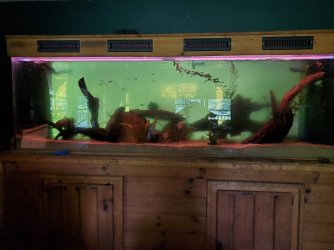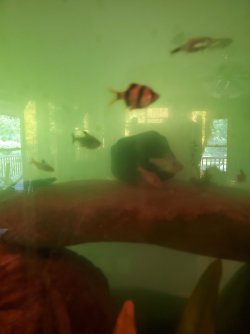pondholler
New Member
I've been reading up here on algae blooms and am not sure where to start to remedy our problem -- dying plants AND a green-water algae bloom.
We have a 300 gallon freshwater planted tank which is underpopulated mostly with various tetras, angelfish, algae eaters and catfish. We've been managing it with weekly water changes without any problems for about 8 months now. However, though the tank is well-lighted, our plants have never thrived. Even the hornwort has become so weak it breaks apart when handled. So we decided to fertilize with NilOCG Thrive Caps. Within about 10 days, our plants looked even worse and we had a green-water algae bloom. Did a huge water change and turned out the lights for three days. That seemed to help with the algae, though the plants looked no better even with lights back on. Within a few days the algae bloom returned and we did another huge water change and turned the lights off again. And that's where we're at.
A few more details. We've been using API StressZyme after weekly water changes. We have a canister filter and two pumps which, among other things, keep the water pretty warm (80-82F in the summer) without a heater. I just tested the water (post water change) and it read 0 ppm for Ammonia, Nitrite, and Nitrate. We've been feeding small amounts of flake food and sinking pellets twice a day. Because our plants seemed to be struggling, we changed our lighting about a month ago to a Hygger (HG-978) lighting system which emits "orange light at dawn, full spectrum light at day and blue light at night" (evening) -- this is from 6:00 am - 6:00 pm. It has 6500-10000 kelvin and 2365 lumens.
From what I'm reading, the StressZyme might be a bad idea. Will definitely cut back on food as well. I've ordered some Water Sprite plants to replace the Hornwort as floaters. I am rather confused about the lighting as we thought we were doing the right thing by the plants, but the good news is that the system is pretty flexible and I can cut back on whatever is too much (fewer hours, less full-spectrum light, etc) if I just know what direction to go in.
We'll read any and all suggestions with great interest. Thanks.
We have a 300 gallon freshwater planted tank which is underpopulated mostly with various tetras, angelfish, algae eaters and catfish. We've been managing it with weekly water changes without any problems for about 8 months now. However, though the tank is well-lighted, our plants have never thrived. Even the hornwort has become so weak it breaks apart when handled. So we decided to fertilize with NilOCG Thrive Caps. Within about 10 days, our plants looked even worse and we had a green-water algae bloom. Did a huge water change and turned out the lights for three days. That seemed to help with the algae, though the plants looked no better even with lights back on. Within a few days the algae bloom returned and we did another huge water change and turned the lights off again. And that's where we're at.
A few more details. We've been using API StressZyme after weekly water changes. We have a canister filter and two pumps which, among other things, keep the water pretty warm (80-82F in the summer) without a heater. I just tested the water (post water change) and it read 0 ppm for Ammonia, Nitrite, and Nitrate. We've been feeding small amounts of flake food and sinking pellets twice a day. Because our plants seemed to be struggling, we changed our lighting about a month ago to a Hygger (HG-978) lighting system which emits "orange light at dawn, full spectrum light at day and blue light at night" (evening) -- this is from 6:00 am - 6:00 pm. It has 6500-10000 kelvin and 2365 lumens.
From what I'm reading, the StressZyme might be a bad idea. Will definitely cut back on food as well. I've ordered some Water Sprite plants to replace the Hornwort as floaters. I am rather confused about the lighting as we thought we were doing the right thing by the plants, but the good news is that the system is pretty flexible and I can cut back on whatever is too much (fewer hours, less full-spectrum light, etc) if I just know what direction to go in.
We'll read any and all suggestions with great interest. Thanks.
Last edited:



